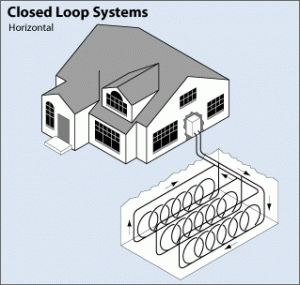Now that you have some information about geothermal energy and why you should use it, Georgia Geothermal is sure that you want to know where geothermal energy comes from.
Before you decide to go with one geothermal energy source over another, make sure you have all the facts about them. Luckily, Georgia Geothermal has already done the research for you and has found that there are three main sources of geothermal energy: horizontal loops, vertical loops, and pond/lake loops.
After you’ve finished reading this article, you should have a better idea which solution will work best for you.
Horizontal Loops
A horizontal loop system is the most cost effective geothermal energy solution—assuming that you have enough room for it in your yard.
Workers use heavy construction vehicles like backhoes and trenchers to dig out trenches about three to six feet below the ground.
Next, they place a set of plastic pipes into the trenches before refilling them, ensuring that nothing compromises the pipes. Fluid then circulates through the pipes in a closed system.
The standard horizontal loop is about 500 feet long for each ton of heating and cooling.
Vertical Loops

Geothermal Vertical Loop
Vertical loop systems are used when yardspace prevents horizontal systems or when you do not want to disrupt your landscape. Vertical loop systems entail a team of men digging a hole ranging in 150-400 feet in depth and then placing a U-shaped pipe in the hole. This pipe is then connected to another pipe that runs horizontally and carries the fluid to and from the indoor exchange unit. Although vertical loops necessitate less pipes and less yardspace than horizontal loops, they are generally more expensive to install than horizontal loop systems, due to the increased amount of labor.
Pond/Lake Loops
This geothermal energy solution requires that the domicile or business be located near some body of water, namely a pond or a lake. Liquid circles through beneath the water in a closed system pipe system (which is often coiled to lessen the amount of space occupied), and because the system is closed, its impact the environment as a result of generating energy is minimal. If you live close to a lake or a pond, then you may want to consider building a geothermal energy solution.
Other Geothermal Energy Sources
Other geothermal energy solutions less widely used as those already discussed include the open loop and standing column well systems. You can read more about both of these options at the GeoExchange.
Now that you have read a little bit about the three sources of geothermal energy, we at Georgia Geothermal are sure you can make a better decision whenever you are choosing a geothermal energy solution for your home. It can be a tough call, but don’t worry.
If you have any other questions about which geothermal energy source will work best for your home or business, please Contact Georgia Geothermal.


